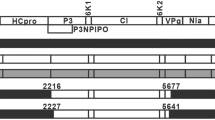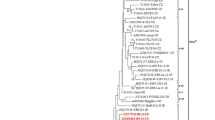Abstract
To investigate the current status of viroid infection in potato fields in Russia, potato spindle tuber viroid (PSTVd) and chrysanthemum stunt viroid (CSVd) were detected in potato (Solanum tuberosum) and S. nigrum plants growing in the Volga (V), North-Western (NW), and Far Eastern (FE) federal districts in Russia. While both PSTVd and CSVd were detected in potato samples from the V and FE regions, only CSVd was detected in potato samples from NW. CSVd was detected in S. nigrum from FE, and this was the first detection of CSVd in S. nigrum. Analysis of the complete genomes of 30 PSTVd and 10 CSVd variants revealed that 5 and 7 PSTVd variants from V and FE, respectively, and 2, 4, and 3 CSVd variants from V, NW, and FE, respectively, were new. Analysis of the infectivity of and symptoms caused by 15 Russian PSTVd isolates in tomato revealed that 14 PSTVd isolates caused intermediate or severe symptoms, and only FP14 caused mild symptoms. Our survey revealed that most of the Russian PSTVd isolates from V and FE caused intermediate symptoms in tomato, and the genome sequences were identical to that of PSTVd isolated from S. demissum. Phylogenetic analysis of nucleotide sequences of the Russian PSTVd variants showed their close relationship to previously studied PSTVd isolates, suggesting that most strains in Russia have not substantially changed genetically, but have widely spread in potato fields.




Similar content being viewed by others
Data availability
The datasets generated during and/or analyzed during the current study are available from the corresponding author on reasonable request.
Code availability
Not relevant.
Change history
24 December 2021
A Correction to this paper has been published: https://doi.org/10.1007/s10658-021-02369-7
References
Behjatnia, S. A. A., Dry, I. B., Krake, L. R., Conde, B. D., Connelly, M. I., Randles, J. W., & Rezaian, M. A. (1996). New potato spindle tuber viroid and tomato leaf curl geminivirus strains from a wild Solanum sp. Phytopathology, 86(8), 880–886.
Di Serio, F., Li, S. F., Pallás, V., Owens, R. A., Randles, J. W., Sano, T., Verhoeven, J. T. T., Vidalakis, G., & Flores, R. (2017). Viroid taxonomy. In A. Hadidi, R. Flores, J. Randles, & P. Palukaitis (Eds.), Viroids and satellites (pp. 135–148). Academic Press.
Diener, O. T., & Raymer, B. W. (1969). Potato spindle tuber virus: A plant virus with properties of a free nucleic acid II. Characterization and partial purification. Virology, 37, 351–366.
Gross, H. J., Domdey, H., Lossow, C., Jank, P., Raba, M., Alberty, H., & Sänger, H. L. (1978). Nucleotide sequence and secondary structure of potato spindle tuber viroid. Nature, 273, 203–208.
Güner, U., Sipahioğlu, H. M., & Usta, M. (2012). Incidence and genetic stability of potato spindle tuber pospiviroid in potato in Turkey. Turkish Journal of Agriculture and Forestry, 36(3), 353–363.
He, L. Y., Zhang, H. L., & Huang, H. (1987). Potato diseases in Asia: Resent and expected developments. Acta Horticulturae, 213, 129–142.
Kastalyeva, T. B., Mozhaeva, K. A., Pisetskaya, N. F., Romanova, S. A., & Trofimets, L. N. (1992). The potato spindle tuber viroid and bringing potato into a healthy state. Vestnik RASKHN, 3, 22–24 (in Russian).
Kastalyeva, T. B., Girsova, N. V., MozhaevaIng, K. A., Ming, L. R., & Owens, A. (2013). Molecular properties of potato spindle tuber viroid (PSTVd) isolates of the Russian research Institute of Phytopathology. Molecular Biology, 47(1), 85–96.
Keese, P., & Symons, R. H. (1985). Domains in viroids: Evidence of intermolecular RNA rearrangements and their contribution to viroid evolution. Proceedings of the National Academy of Sciences of the United States of America, 82, 4582–4586.
Kumar, S., Stecher, G., & Tamura, K. (2016). MEGA7: Molecular evolutionary genetics analysis version 7.0 for bigger datasets. Molecular Biology and Evolution, 33(7), 1870–1368.
Larkin, M. A., Blackshields, G., Brown, N. P., Chenna, R., McGettigan, P. A., McWilliam, H., Valentin, F., Wallace, I. M., Wilm, A., Lopez, R., Thompson, J. D., Gibson, T. J., & Higgins, D. G. (2007). Clustal W and Clustal X version 2.0. Bioinformatics, 23(21), 2947–2948.
Ma, Y., Marais, A., Lefebvre, M., Faure, C., & Candresse, T. (2020). Metagenomic analysis of virome cross-talk between cultivated Solanum lycopersicum and wild Solanum nigrum. Virology, 540(15), 38–44.
Mackie, A. E., Coutts, B. A., Barbetti, M. J., Rodoni, B. C., McKirdy, S. J., & Jones, R. A. C. (2015). Potato spindle tuber viroid: Stability on common surfaces and inactivation with disinfectants. Plant Disease, 99, 770–775.
Mackie, A. E., Rodoni, B. C., Barbetti, M. J., McKirdy, S. J., & Jones, R. A. C. (2016). Potato spindle tuber viroid: Alternative host reservoirs and strain found in a remote subtropical irrigation area. European Journal of Plant Pathology, 145, 433–446.
Matsushita, Y. (2013). Chrysanthemum stunt viroid. Japan Agricultural Research Quarterly, 47(3), 237–247.
Matsushita, Y., & Penmetcha, K. K. R. (2009). In vitro transcribed Chrysanthemum stunt viroid (CSVd) RNA is infectious to chrysanthemum and other plants. Phytopathology, 99(1), 58–66
Matsushita, Y., Kanda, A., Usugi, T., & Tsuda, S. (2008). First report of a tomato chlorotic dwarf viroid disease on tomato plants in Japan. Journal of General Plant Pathology, 74(2), 182–184.
Matsushita, Y., Usugi, T., & Tsuda, S. (2011). Distribution of tomato chlorotic dwarf viroid in floral organs of tomato. European Journal of Plant Pathology, 130, 441–447.
Matsushita, Y., Yanagisawa, H., & Sano, T. (2018). Vertical and horizontal transmission of pospiviroids. Viruses, 10(12), 706. https://doi.org/10.3390/v10120706.
Matsushita, Y., Yanagisawa, H., Khiutti, A., Mironenko, N., Ohto, Y., & Afanasenko, O. (2019). First report of chrysanthemum stunt viroid isolated from potato (Solanum tuberosum) plants in Russia. Journal of General Plant Pathology, 85(4), 311–313.
Owens, R. A., & Verhoeven, J. T. T. (2017). Potato spindle tuber viroid. In A. Hadidi, R. Flores, J. Randles, & P. Palukaitis (Eds.), Viroids and satellites (pp. 149–158). Academic Press.
Owens, R. A., Steger, G., Hu, Y., Fels, A., Hammond, R. W., & Riesner, D. (1996). RNA structural features responsible for potato spindle tuber viroid pathogenicity. Virology, 222, 144–158.
Owens, R. A., Girsova, N. V., Kromina, K. A., Lee, I. M., Mozhaeva, K. A., & Kastalyeva, T. (2009). Russian isolates of potato spindle tuber viroid exhibit low sequence diversity. Plant Disease, 93(7), 752–759.
Qi, Y., & Ding, B. (2003). Inhibition of cell growth and shoot development by a specific nucleotide sequence in a noncoding viroid RNA. Plant Cell, 15, 1360–1374.
Qiu, C-L., Zhang, Z-X., Li, S-F., Bai, Y-J, Liu, S-W., Fan, G-Q., Gao, Y-L, Zhang, W. Zhang, S., Lu, W.-H., & Lu, D.-Q. (2016). Occurrence and molecular characterization of potato spindle tuber viroid (PSTVd) isolates from potato plants in North China. Journal of Integrative Agriculture, 15(2), 349–363.
Romanova, S. A., Volkov, Y., Kakareka, N., Pleshakova, T. I., & Koslovskaya, Z. N. (2007). Potato disease caused by combined infection with potato spindle tuber viroid and potato virus Y necrotic strain. Russian Agricultural Sciences, 33, 162–165.
Sano, T., Candresse, T., Hammond, R. W., Diener, T. O., & Owens, R. A. (1992). Identification of multiple structural domains regulating viroid pathogenicity. Proceedings of the National Academy of Sciences of the United States of America, 89(21), 10104–10108.
Schmitz, A., & Riesner, D. (1998). Correlation between bending of the VM region and the pathogenicity of different potato spindle tuber viroid strains. RNA, 4, 1295–1303.
Schnölzer, M., Haas, B., Ramm, K., Hofmann, H., & Sanger, H. L. (1985). Correlation between structure and pathogenicity of potato spindle tuber viroid (PSTV). EMBO Journal, 4, 2181–2190.
Singh, R. P. (1970). Seed transmission of potato spindle tuber virus in tomato and potato. American Potato Journal, 47, 225–227.
Singh, R. P. (1973). Experimental host range of the potato spindle tuber ‘virus’. American Potato Journal, 50, 111–123.
Singh, R. P., Boucher, A., & Wang, R. G. (1991). Detection, distribution and long-term persistence of potato spindle tuber viroid in true potato seed from Heilongjiang, China. American Potato Journal, 68, 65–74.
Singh, R. P., Singh, M., Boucher, A., & Owens, R. A. (1993). A mild strain of potato spindle tuber viroid from China is similar to north American isolates. Canadian Journal of Plant Pathology, 15, 134–138.
Tien, P. (1985). Viroids and viroid diseases of China. In K. Maramorosch & J. J. McKelvey Jr. (Eds.), Subviral pathogens of plants and animals; Viroids and prions (pp. 123–136). Academic Press.
Verhoeven, J. T. J., Jansen, C. C. C., & Roenhurst, J. W. (2004). Natural infections of tomato by Citrus exocortis viroid, Columnea latent viroid, potato spindle tuber viroid and tomato chlorotic dwarf viroid. European Journal of Plant Pathology, 110, 823–831.
Yanagisawa, H., & Matsushita, Y. (2017). Host ranges and seed transmission of tomato planta macho viroid and pepper chat fruit viroid. European Journal of Plant Pathology, 149, 211–217.
Yanagisawa, H., Shiki, Y., Matsushita, Y., Ooishi, M., Takaue, N., & Tsuda, S. (2017). Development of a comprehensive detection and identification molecular based system for eight pospiviroids. European Journal of Plant Pathology, 149, 11–23.
Yanagisawa, H., Sano, T., Hase, S., & Matsushita, Y. (2019). Influence of the terminal left domain on horizontal and vertical transmissions of tomato planta macho viroid and potato spindle tuber viroid through pollen. Virology, 526, 22–31.
Zuker, M. (2003). Mfold web server for nucleic acid folding and hybridization prediction. Nucleic Acids Research, 31, 3406–3415.
Acknowledgments
We thank Dr. T. K. Kovalenko, head of the Department of Biological Methods of Plant Protection at the Federal State Budget Scientific Institution “Far Eastern Research Institute of Plant Protection,” for helping us sample potato tubers, and Y. Narita and Y. Matsumura for preparing the experimental materials. This study was supported, in part, by the Strategic International Collaborative Research Project promoted by the Ministry of Agriculture, Forestry and Fisheries, Tokyo, Japan (No. J008837) administered by the Ministry of Agriculture, Forestry and Fisheries in Japan, and in part by a grant from the Russian Science Foundation (No. 20-46-07001).
Funding
This study was supported, in part, by the Strategic International Collaborative Research Project promoted by the Ministry of Agriculture, Forestry and Fisheries, Tokyo, Japan (No. J008837) administered by the Ministry of Agriculture, Forestry and Fisheries in Japan, and in part by a grant from the Russian Science Foundation (No. 20–46-07001).
Author information
Authors and Affiliations
Contributions
All authors contributed to the study conception and design. Material preparation was performed by Yosuke Matsushita, Hironobu Yanagisawa, Aleksandr Khiutti, Nina Mironenko, Yasuo Ohto and Olga Afanasenko. Data collection and analysis were performed by Hironobu Yanagisawa, Yosuke Matsushita, Aleksandr Khiutti and Nina Mironenko. The first draft of the manuscript was written by Yosuke Matsushita and Hironobu Yanagisawa and all authors commented on previous versions of the manuscript. All authors read and approved the final manuscript.
Corresponding author
Ethics declarations
Ethics approval
Not applicable.
Consent to participate
Not applicable.
Consent for publication
Not applicable.
Conflict of interest
The authors declare no conflicts of interest.
Rights and permissions
About this article
Cite this article
Matsushita, Y., Yanagisawa, H., Khiutti, A. et al. Genetic diversity and pathogenicity of potato spindle tuber viroid and chrysanthemum stunt viroid isolates in Russia. Eur J Plant Pathol 161, 529–542 (2021). https://doi.org/10.1007/s10658-021-02339-z
Accepted:
Published:
Issue Date:
DOI: https://doi.org/10.1007/s10658-021-02339-z




